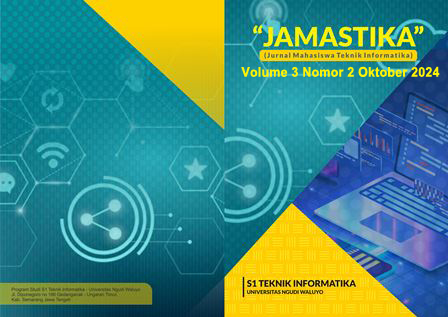Pemetaan Proyeksi Penduduk Indonesia (Menurut Jenis Kelamin) dengan Pendekatan Machine Learning
Mapping Indonesian Population Projections (By Gender) using a Machine Learning Approach
DOI:
https://doi.org/10.35473/jamastika.v3i2.3210Abstract
The use of Machine Learning techniques has become a vital method in predicting future population numbers. In Indonesia, population projections based on gender have a significant impact in planning national development. This research proposes an approach that utilizes Machine Learning modeling techniques to project the population of Indonesia based on gender. The dataset used includes various information such as population, province, year, and gender. The modeling process involves stages such as data preparation, model selection, model training, evaluation, and validation. The projection results are then assessed using various relevant model performance evaluation metrics.
ABSTRAK
Penggunaan Teknik Machine Learning telah menjadi sebuah metode yang vital dalam meramalkan jumlah penduduk di masa depan. Di Indonesia, proyeksi jumlah penduduk berdasarkam jenis kelamin memiliki dampak yang signifikan dalam merencanakan Pembangunan nasional. Peneletian ini mengusulkan suatu pendekatan yang memanfaatkan Teknik pemodelan Machine Learning untuk memproyeksikan jumlah penduduk Indonesia berdasarkan jenis kelamin. Dataset yang digunakan mencakup berbagai informasi seperti jumlah penduduk, provinsi, tahun, dan jenis kelamin. Proses pemodelan melibatkan tahapan-tahapan seperti persiapan data, pemodelan, dan evaluasi. Hasil proyeksi kemudian dinilai menggunakan berbagai metrik evaluasi kinerja model yang relevan.
References
Annahl, M. A. (23. 10 2020). Performance Management in Indonesia Zakat Institutions: Balanced Scorecard and Fuzzy DEMATEL Framework. (2020: The 4th International Conference of Zakat (ICONZ) Proceeding). Surabaya. doi:https://doi.org/10.37706/iconz.2020.231
Arnolus Juantri E. Oktavianus, L. N. (2023). Pemanfaatan Artificial Intelligence pada Pembelajaran dan Asesmen di Era Digitalisasi. JURNAL KRIDATAMA SAINS DAN TEKNOLOGI, 5(2), 473-484.
Elsa G. Guillot, M. K. (2013). Climate Change Influenced Female Population Sizes Through Time Across the Indonesian Archipelago. Human Biology, 135-152. doi:https://doi.org/10.3378/027.085.0306
Emma V. A. Sylvester, P. B. (2017, July 11). Applications of Random Forest feature selection for fine- scale genetic population assignment. Evolutionary Applications, 11, 153-165. doi:https://doi.org/10.1111/eva.12524
Forrest R. Stevens, A. E. (2015). Disaggregating Census Data for Population Mapping Using Random Forests with Remotely-Sensed and Ancillary Data. Northwestern University. Evanston: Plos One. doi:https://doi.org/10.1371/journal.pone.0107042
Hossin, M. S. (2015). A Review on Evaluation Metrics For Data Classification Evaluations. International Journal of Data Mining & Knowledge Management Process, 5(2). Von https://www.aircconline.com/ijdkp/V5N2/5215ijdkp01.pdf
Juanmei Liu, Z.-H. T. (2013). Artificial Neural Network models for prediction of cardiovascular autonomic dysfunction in generalChinese population. BMC Medical Informatics and Decision Making, 13. Von http://www.biomedcentral.com/1472-6947/13/80
Max Jaderberg, V. D. (2017). Population Based Training of Neural Networks. arXiv. doi:https://doi.org/10.48550/arXiv.1711.09846
McDonald, P. (2014). A Population Projection for Indonesia, 2010–2035. Bulletin of Indonesian Economic Studies, 123-129. doi:https://doi.org/10.1080/00074918.2014.896240
Ni Komang Arista Dewi, a. L. (2020). PEMETAAN BENTUK DAN PENCEGAHAN PENIPUAN E-COMMERCE. E-Jurnal Ekonomi dan Bisnis Universitas Udayana 9.9, 851-878.
Panggabean, M. (2020). Faktor-Faktor Yang Mempengaruhi Dependency Ratio di Indonesia. Prosiding Seminar Akademik Tahunan Ilmu Ekonomi dan Studi Pembangunan 2020, 371-387.
Rémi Abgrall, É. L. (2022). Relaxation Deferred Correction Methods and their Applications to Residual Distribution Schemes. SMAI Journal of Computational Mathematics, 8, 125-160. doi:https://doi.org/10.5802/smai-jcm.82
Roma Akbar Iswara, E. S. (2018). Sistem Pendukung Keputusan Untuk penentuan mustahik (Penerima Zakat) Menggunakan Metode Fuzzy AHP (F-AHP). Jurnal Pengembangan Teknologi Informasi dan Ilmu Komputer, 1306-1312.
Sara Sheehan, Y. S. (28. March 2016). Deep Learning for Population Genetic Inference. Rutgers University. PLOS COMPUTATIONAL BIOLOGY. doi:https://doi.org/10.1371/journal.pcbi.1004845
TAFHAMIN, D. A. (2020). APLIKASI SOFTWARE SPECTRUM UNTUK GAMBARAN PROYEKSI PENDUDUK KOTA SURABAYA TAHUN 2018-2028. AIRLANGGA University, Surabaya. Von https://media.neliti.com/media/publications/50568-ID-proyeksi-penduduk-indonesia-per-provinsi-menurut-kelompok-umur-dan-jenis-kelamin.pdf
Yang Zhao, F. C. (2012). Correction for population stratification in Random Forest analysis. International Journal of Epidemiology, 41(6), 1798–1806. doi:https://doi.org/10.1093/ije/dys183
Yudistira, N. (2018). Peran Big Data dan Deep Learning untuk Menyelesaikan Permasalahan Secara Komprehensif. EXPERT Jurnal Manajemen Sistem Informasi dan Teknologi, 11, 79-89. doi:http://dx.doi.org/10.36448/expert.v11i2.2063









